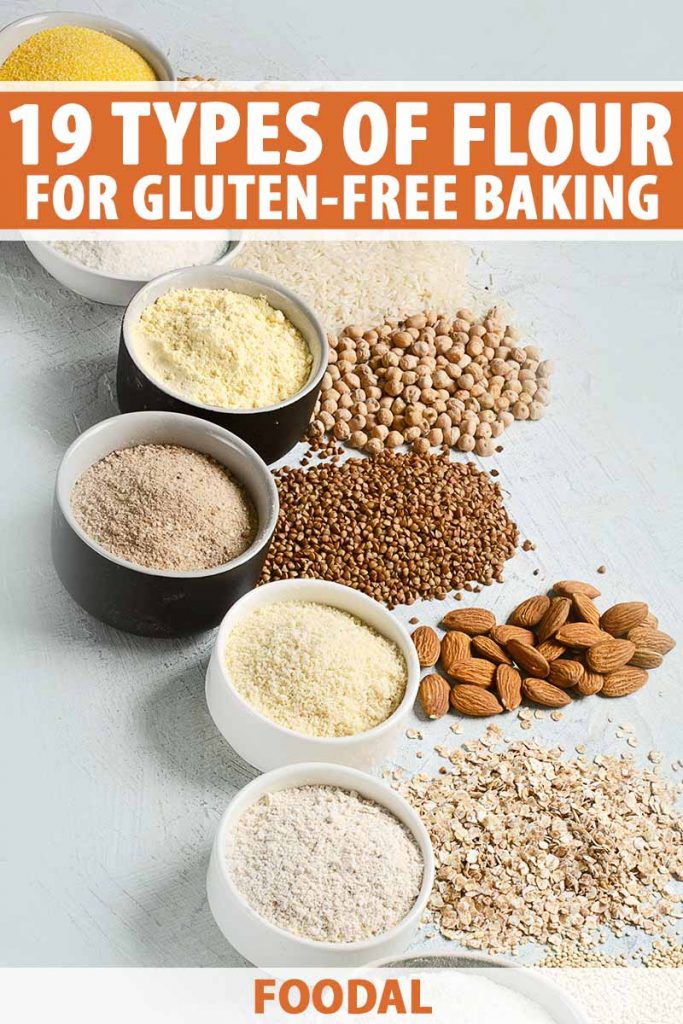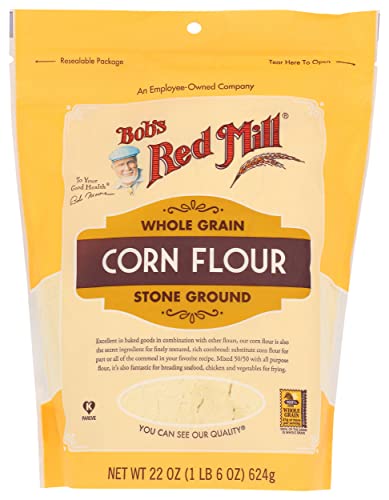We occasionally link to goods offered by vendors to help the reader find relevant products. Some of these may be affiliate based, meaning we earn small commissions (at no additional cost to you) if items are purchased. Here is more about what we do.
If you are looking for gluten-free (GF) flour to use instead of wheat in baked goods, you’ve come to the right place. I’ve been eating gluten-free for 30 years for celiac disease. Way back when, options were few, recipes were scarce, and it was hard not to feel deprived.
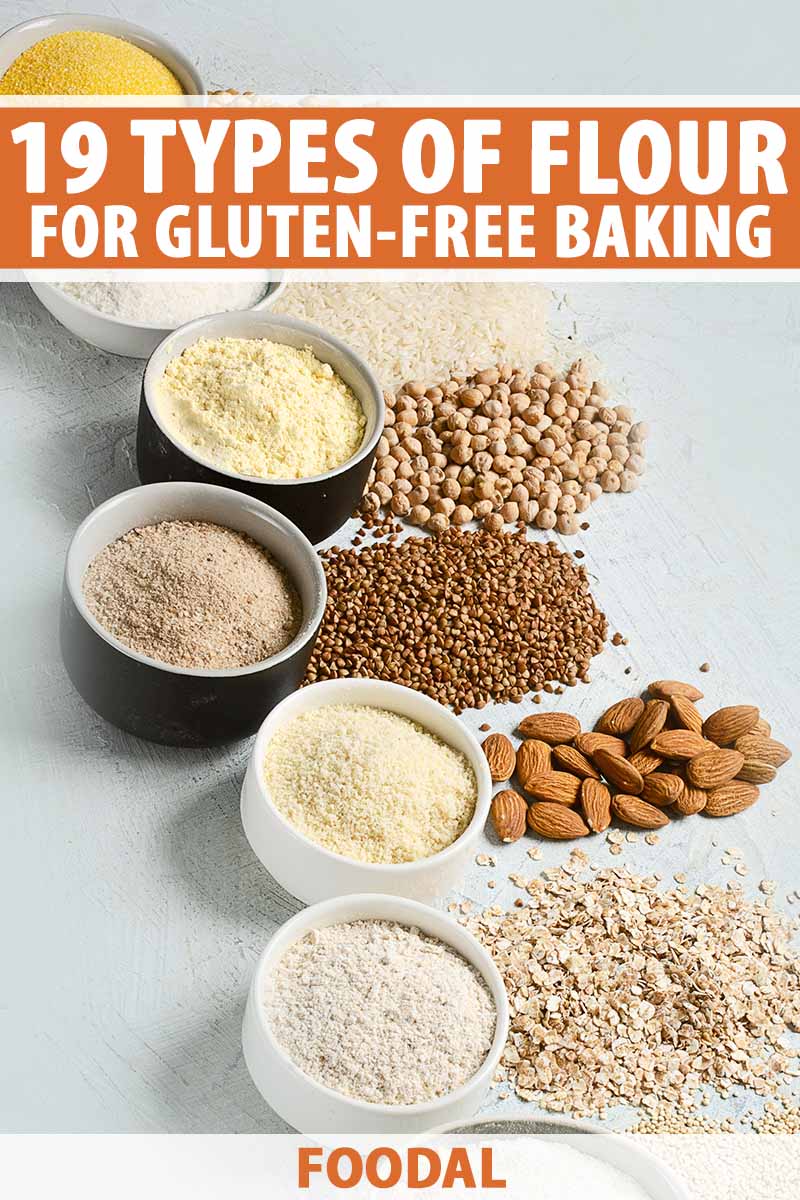
Happily, gluten-free has come a long way. Ingredients, recipes, and prepared products are readily available. You’ll find delicious inspiration in the gluten-free recipe section of Foodal.
This guide introduces 19 types of gluten-free flour with tips for using them as wheat-free substitutions in baked goods.
Here’s the lineup:
19 Gluten-Free Baking Flours
Before we introduce alternatives for baking without wheat, be advised that if you have allergies to corn, grasses, and/or nuts, you should avoid products that contain them. And if you are following a low-FODMAP elimination diet, avoid legumes like chickpeas to prevent exacerbating symptoms.
Some GF alternatives contain more protein than others. They bind better because they can absorb more moisture and bake to a more tender crumb than lower protein products.
GF recipes account for this and often call for additional binders, like egg, guar gum, starch, or xanthan gum, to improve elasticity and texture for a more wheat-like bake.
Ready to head to the kitchen? Here are 19 options to consider:
1. Almond
We make almond flour by removing the nut skins, blanching the nut meats, and grinding them into a fine powder. This differs from almond meal, which consists of coarse-ground whole, skin-on, raw almonds.
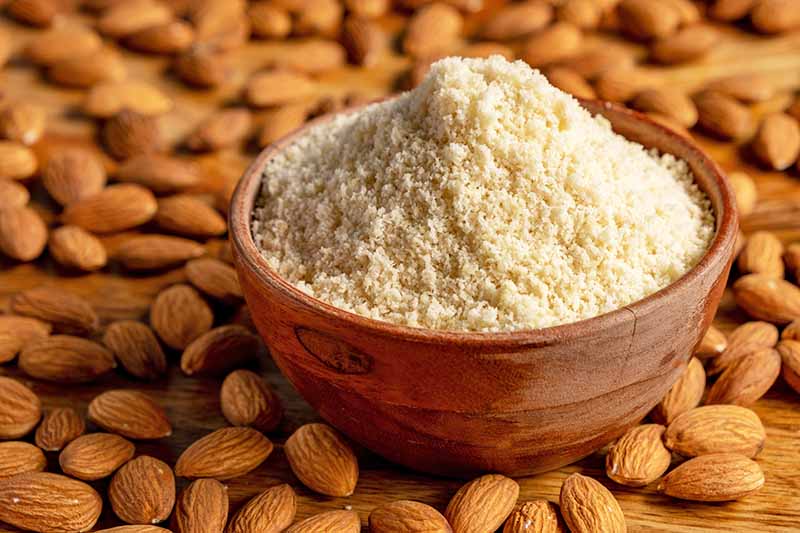
Substitute a cup for a cup in recipes calling for wheat. You may need more of your binding ingredients, like egg or milk, to hold the dough together.
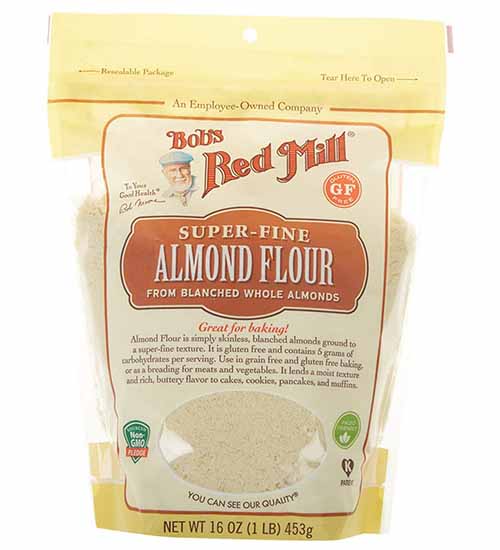
Bob’s Red Mill Almond Flour, available on Amazon
Bob’s Red Mill Almond Flour is ground super fine. A quarter cup contains 8 grams of protein, 2 grams of fiber, 10 grams of fat, 10 grams of carbohydrates, and 160 calories. Enjoy its rich, buttery flavor in baked goods, or use it in pancake batter or as breading.
This ingredient from Bob’s Red Mill is available via Amazon.
2. Amaranth
Grinding the seeds of amaranth yields a fine powder suited to baking unleavened cookies, crackers, and flatbreads. It has a grassy, nutty, corn-like flavor.
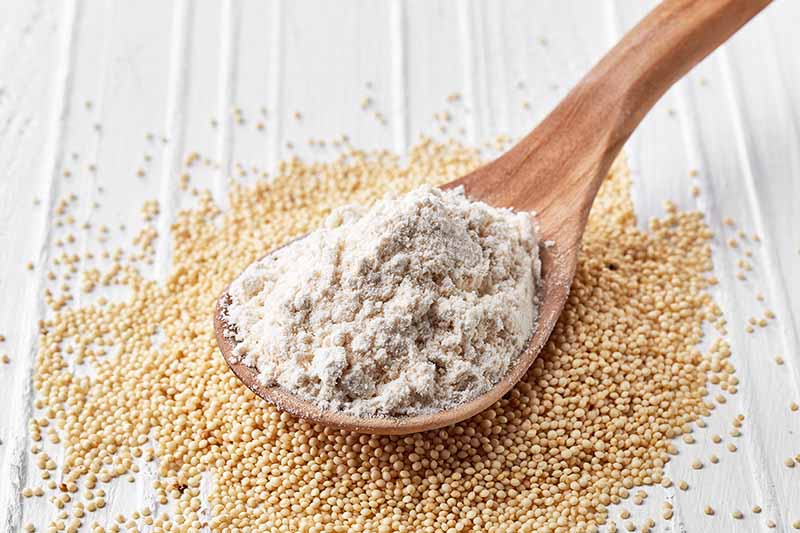
Amaranth is not a cup-for-cup substitute for wheat in baked goods but an alternative for unleavened baking, using recipes developed for its use or in combination with other gluten-free ingredients.

Bob’s Red Mill Organic Amaranth Flour, available on Amazon
A quarter cup of Bob’s Red Mill Organic Amaranth Flour contains 5 grams of protein, 2 grams of fat, 4 grams of fiber, 25 grams of carbs, and 140 calories. In addition to baking, we use amaranth as a breakfast cereal, pancake batter, and thickener for gravies and sauces.
Bob’s Red Mill Organic Amaranth Flour is available via Amazon.
Read more in our guide, “Amaranth, a Splendid Gluten-Free Alternative to Wheat.”
3. Arrowroot
Arrowroot flour, powder, or starch is extracted from the tropical tuberous roots of the arrowroot plant.
It has a neutral flavor and is used primarily as a thickening agent that adds a non-cloudy, glossy silkiness to sauces and gravies. When used in baking, it helps to bind ingredients together for a light, fluffy product.
Anthony’s Arrowroot Flour, available on Amazon
The rule of thumb for substitution is one teaspoon of arrowroot for every tablespoon of wheat.
You can also substitute it for cornstarch, tablespoon for tablespoon. Like cornstarch, we dissolve it in cold water before use to thicken something like a gravy. Note that it does not reheat well when used for this purpose and loses its thickening properties as it ages.
Anthony’s Arrowroot Flour contains 0 grams of protein, less than 1 gram of fiber, 0 grams of fat, 26 grams of carbohydrates, and 110 calories per quarter cup. The lower fat and protein levels make for quick thickening.
This ingredient is available via Amazon.
4. Banana and Plantain
Obtaining ground banana and plantain requires drying the fruits when they are green and milling them into a fine powder. Both are rich in resistant starch that is prebiotic and gut-friendly, qualifying them for “superfood” status.

A quarter cup of ground banana contains 1 gram of protein, 2 grams of fiber, 0 grams of fat, 23 grams of carbohydrates, and 95 calories. It has a slightly sweet flavor.
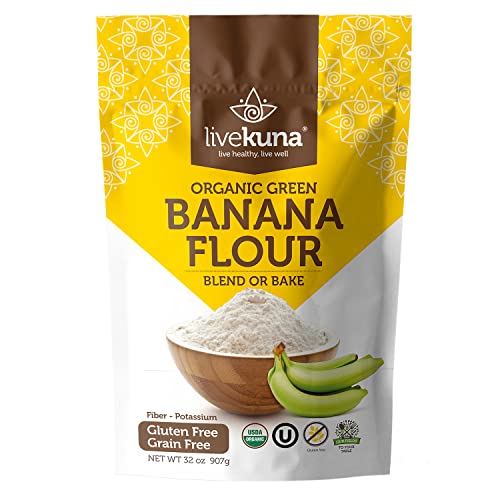
LiveKuna Organic Green Banana Flour, available on Amazon
For baking, substitute at a ratio of three-quarters of a cup of banana per cup of wheat. To substitute for self-rising wheat flour products that contain baking powder, you’ll need to add two teaspoons of baking powder to one cup of banana. You can also use these banana-based ingredients in in smoothies and to thicken gravies and sauces.
LiveKuna Organic Green Banana Flour is available via Amazon.
Plantains are larger than bananas. The skin is thicker, and the fruit contains less sugar and more starch.
Iya Foods Green Plantain Flour, available on Amazon
Ground plantain has 1 gram of protein, 2 grams of fiber, 0 grams of fat, 33 grams of carbohydrates, and 90 calories per quarter cup.
Iya Foods GreenPlantain Flour is available via Amazon.
5. Buckwheat
Buckwheat is a flowering plant with grain-like seeds that we harvest and grind into powder. And even though it’s not botanically a grain or grass, we speak of it as a “whole grain” and appreciate it for having the nine essential amino acids that equal a complete protein.
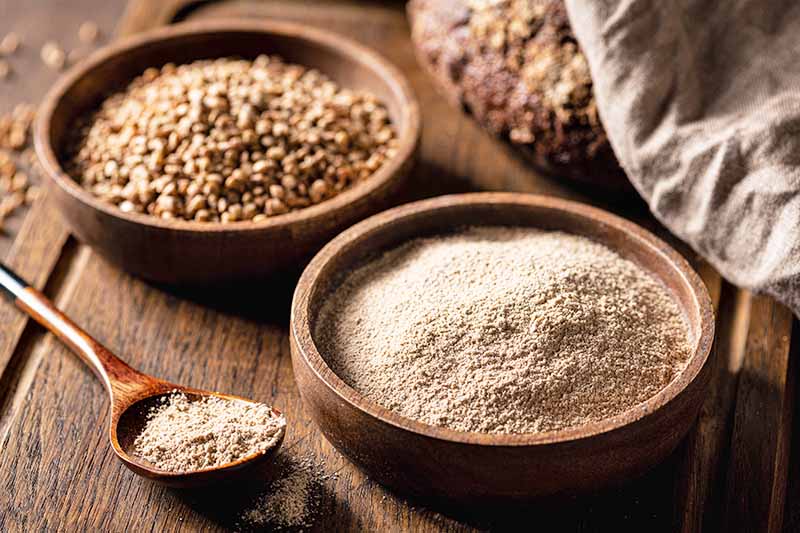
It has an earthy flavor that’s somewhat bitter and nutty.
Often used in pancake batter, buckwheat is heavy, fiber-rich, and best used with other wheat-free alternatives. It contributes volume and improves the texture of baked goods by yielding a soft crumb.

Anthony’s Organic Buckwheat Flour, available on Amazon
This product has 2 grams of protein, less than 1 gram of fiber, 0 grams of fat, 23 grams of cholesterol, and 100 calories per quarter cup.
Anthony’s Organic Buckwheat Flour is available via Amazon.
6. Cassava and Tapioca
We get cassava flour by drying and grinding tropical cassava tubers. It is nutrient- and fiber-rich with a slightly nutty to neutral flavor.

Tapioca flour, aka tapioca starch, comes from the same root. But instead of using it in its entirety, it’s filtered, peeled, pulled, and dehydrated to make a fine, powdery starch devoid of the nutrients and fiber of cassava.
In addition to thickening gravies, pie fillings, soups, and stews, cassava and tapioca improve the crumb structure of baked goods for a springy texture.
Otto’s Natural Organic Cassava Flour, available on Amazon
Use two-thirds of a cup of cassava to one cup of wheat, adjusting as needed to achieve the desired dough or batter consistency.
It contains 1 gram of protein, 3 grams of fiber, 0 grams of fat, 28 grams of carbohydrates, and 110 calories per quarter cup.
Otto’s Natural Organic Cassava Flour is available via Amazon.
Use one cup of tapioca for every cup of wheat when baking, and two tablespoons of tapioca for every tablespoon of cornstarch for thickening.
Bob’s Red Mill Tapioca Flour, available on Amazon
Tapioca flour has 0 grams of protein, 0 grams of fiber, 0 grams of fat, 27 grams of carbohydrates, and 110 calories per quarter cup.
This variety of flour from Bob’s Red Mill is available via Amazon.
7. Cauliflower
Dried and ground cauliflower florets make for another healthy and practical wheat alternative. It is especially good in quick breads and pizza crusts.
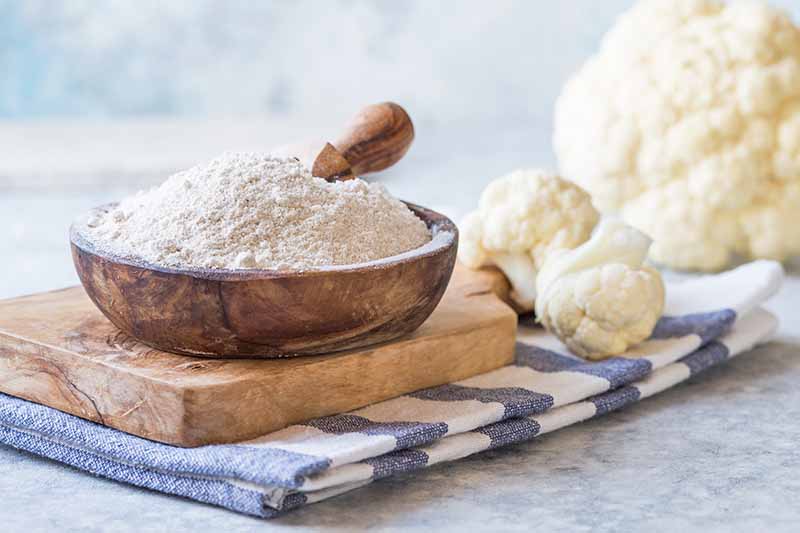
Substitute a cup of dried, ground cauliflower for a cup of wheat.
Judee’s Cauliflower Flour, available on Amazon
Dried, ground cauliflower contains 4 grams of protein, 4 grams of fiber, 0 grams of fat, 28 grams of carbohydrates, and 120 calories per quarter cup.
This unique product from Judee’s is available via Amazon.
8. Chickpea
Chickpea, aka garbanzo or cici bean, consists of dried, hulled, and milled beans. It has a robust, earthy flavor that can overpower a recipe unless used in moderation with other wheat alternatives, at 25 percent of the whole blend.
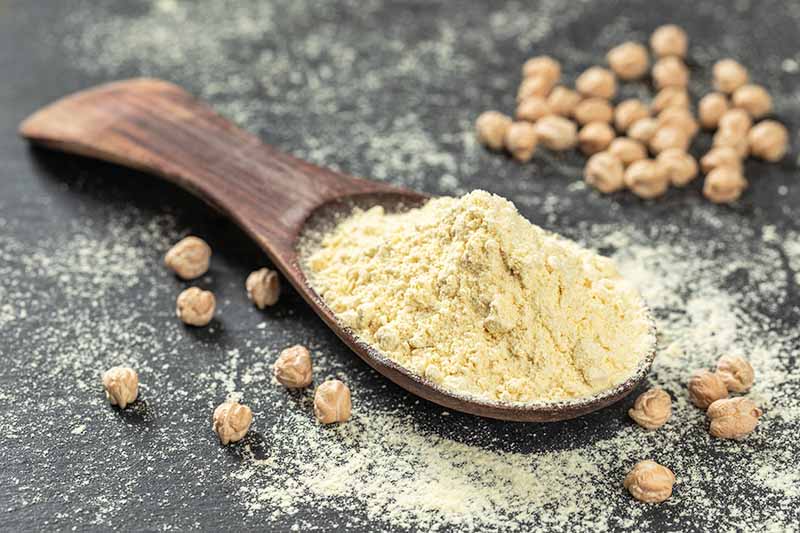
Dried, ground chickpeas bind well and are a good choice for adding fiber and earthy notes to quick breads and muffins.
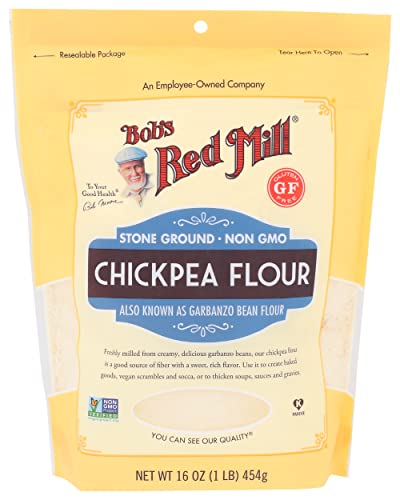
Bob’s Red Mill Chickpea Flour, available on Amazon
Dried, ground chickpeas have 5 grams of protein, 5 grams of fiber,1.5 grams of fat, 21 grams of carbohydrates, and 120 calories per quarter cup.
Bob’s Red Mill Chickpea Flour is available via Amazon.
9. Coconut
After extracting the coconut milk, the dried fruit pulp is ground finely to make a powder.
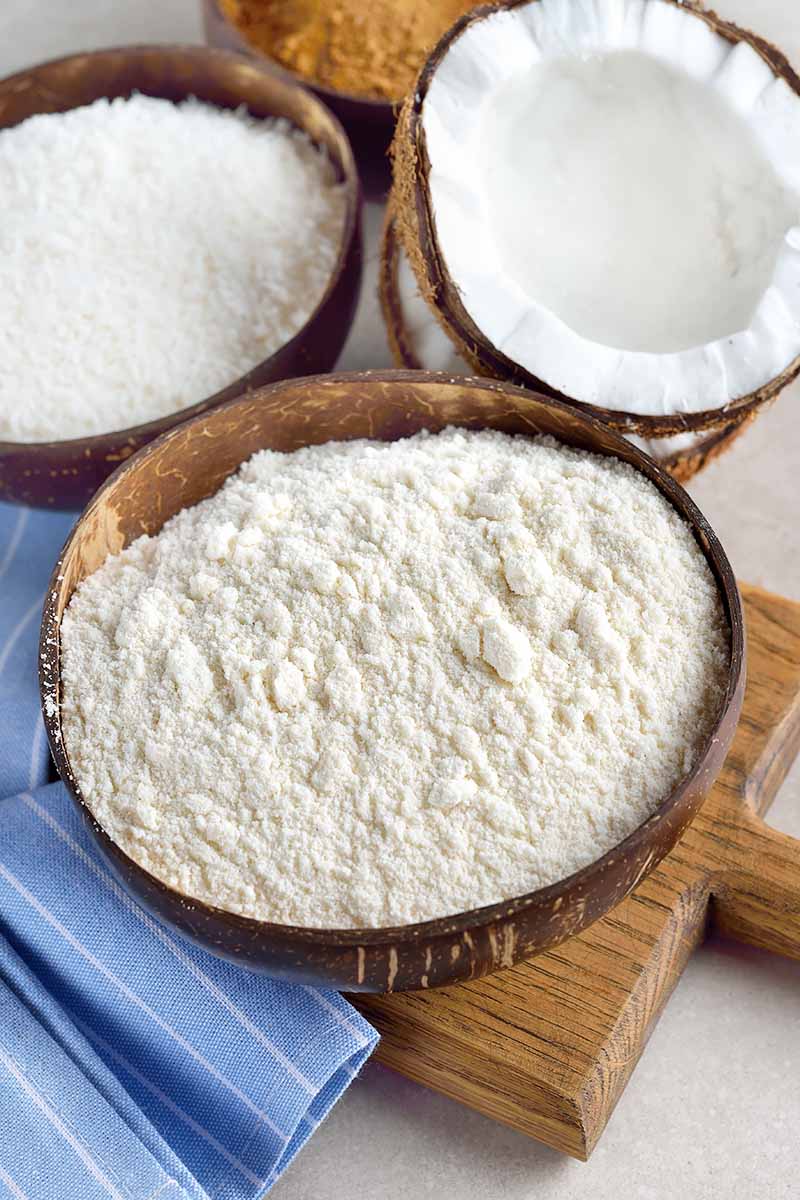
Because it is rich in fiber, powdered coconut absorbs water readily. For this reason, it’s best to substitute a third to a quarter cup of coconut for a cup of wheat and to increase the number of eggs called for. This is a real trial-and-error ingredient, with a mildly sweet flavor that makes for delectably moist baked goods.
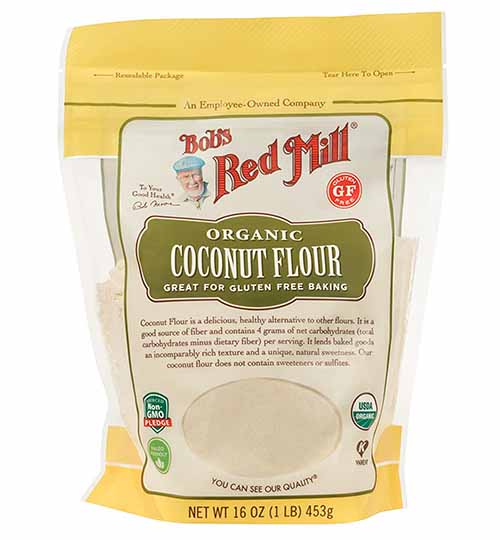
Bob’s Red Mill Organic Coconut Flour, available on Amazon
Powdered, dried coconut has 6 grams of protein, 10 grams of fiber, 3 grams of fat, 18 grams of carbohydrates, and 120 calories in a quarter cup.
An organic variety from Bob’s Red Mill is currently available to buy via Amazon.
10. Corn
We make corn, aka maize, flour by milling whole, dry kernels to a fine powder. Cornmeal is a coarser ground product. And cornstarch is the ground, starchy endosperm portion of the grain.
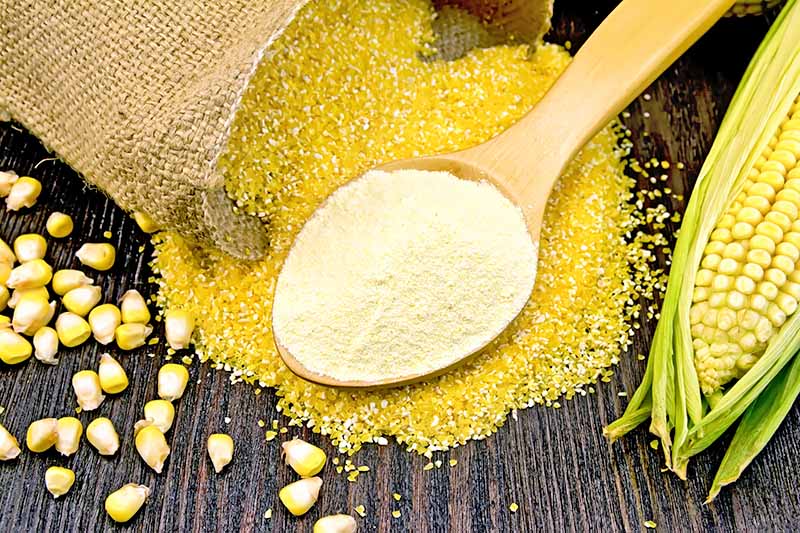
Corn flour results in a smoother texture than cornmeal. Both work well in combination with other wheat-free alternatives. When using corn alone, it replaces wheat at a third to a half of the amount called for.
Corn starch used in baked goods yields a tender crumb.
Bob’s Red Mill Stone-Ground Corn, available on Amazon
It contains 2 grams of protein, 1 gram of fat, 3 grams of fiber, 24 grams of carbohydrates, and 120 calories per quarter cup.
Bob’s Red Mill Stone-Ground Corn is available to purchase now via Amazon.
11. Hazelnut
We make hazelnut flour by hulling and grinding dry nuts. It makes an excellent pie crust and a rich addition to cakes, cookies, and pies.
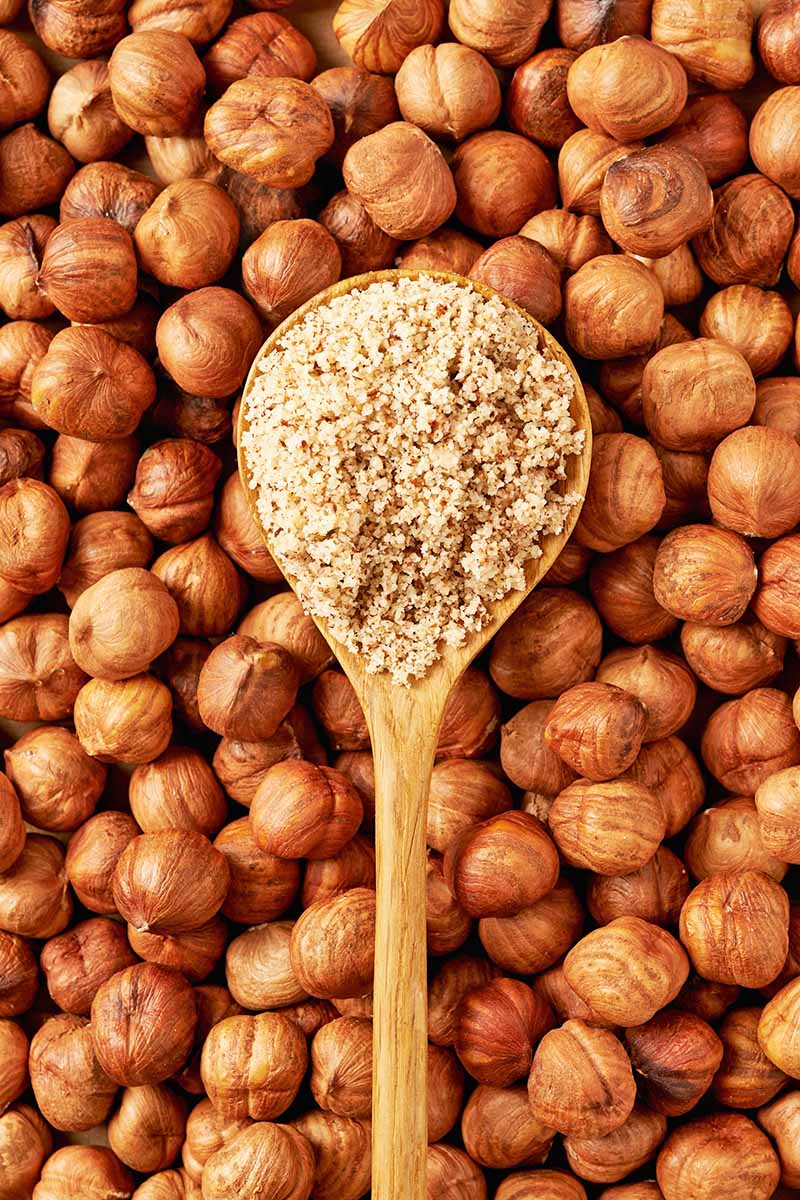
Replace 30 percent of the flour called for with hazelnut and the remaining portion with one or more gluten-free alternatives to wheat.
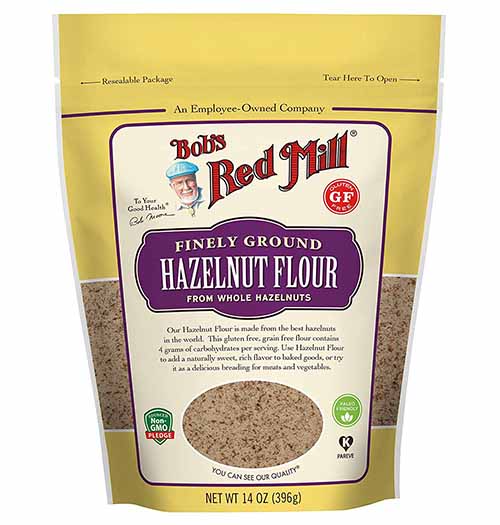
Bob’s Hazelnut Flour, available on Amazon
Dried, ground hazelnuts contain 4 grams of protein, 4 grams of fiber, 12 grams of fat, 8 grams of carbohydrates, and 160 calories per quarter cup.
This variety of ground nut from Bob’s Red Mill is available via Amazon.
12. Millet
Millet is the name of multiple types of cereal grass. It is finely milled and used in recipes for breads, rolls, and other baked goods.
We combine millet with other varieties at a quantity of up to 25 percent of the total amount called for in a recipe.
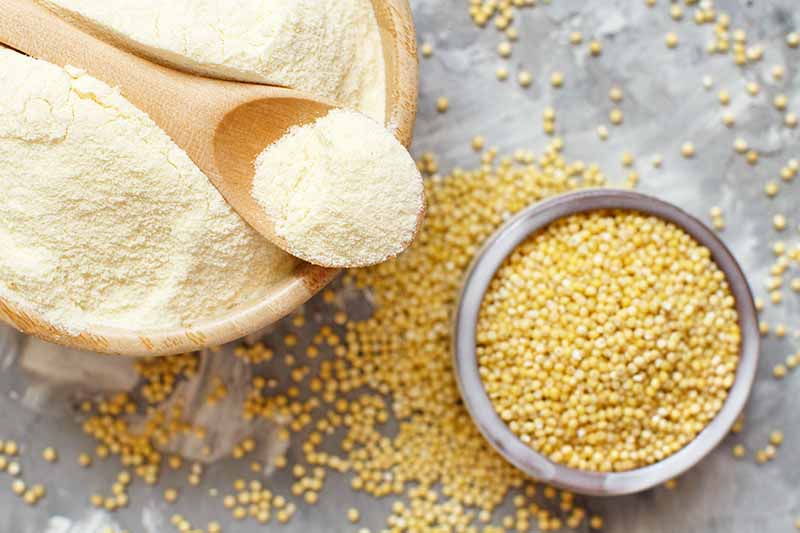
Millet is a whole grain with a mildly sweet flavor that contributes volume and improves texture for a moist, delicate crumb.
Bob’s Red Mill Stone-Ground Millet, available on Amazon
Dried, ground millet contains 4 grams of protein, 1 gram of fiber, 2 grams of fat, 31 grams of carbohydrates, and 150 calories per quarter cup.
Bob’s Red Mill Stone-Ground Millet is available to purchase now via Amazon.
13. Oat
Oats are a type of cereal grass. We make oat flour by removing the hulls and milling the dried seeds or groats into a fine powder.

Rich in fiber, finely ground oats have an earthy, nutty flavor. Substitute one and a quarter cups of oat for one cup of wheat. You can also add up to 20 percent oat to another flour or blend to vary the flavor and change the nutritional content of quick breads, cookies, and muffins.
Using oats may require adding more liquid ingredients to maintain moisture for a tender final result. Trial and error are the best teachers as you try recipes using this wheat alternative.

Bob’s Red Mill Oat Flour, available on Amazon
This particular variety from Bob’s Red Mill has 4 grams of protein, 4 grams of fiber, 1.5 grams of fat, 22 grams of carbohydrates, and 120 calories per quarter cup.
Bob’s Red Mill Oat Flour is available via Amazon.
14. Pistachio
We make pistachio flour by removing the skins, blanching, and grinding the nuts into a fine powder. It is best used as part of a blend, as it bakes to a dense consistency. Add it when you want to increase the protein content of a recipe, and enjoy its earthy, buttery flavor.

You can substitute a cup of pistachio for a cup of other finely ground nut varieties, such as the almonds in macarons.
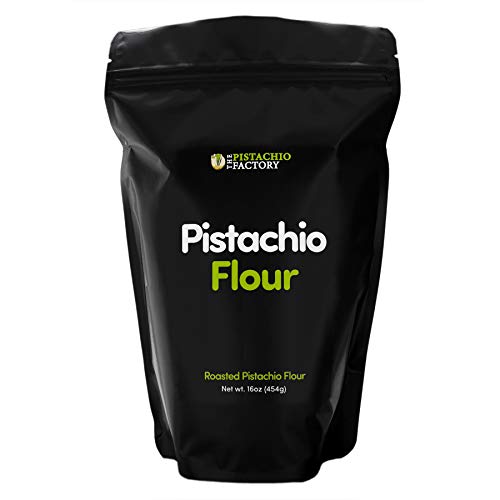
Pistachio Factory Pistachio Flour, available on Amazon
Pistachio flour has 7 grams of protein, 3 grams of fiber, 13 grams of fat, 8 grams of carbohydrates, and 160 calories in a quarter cup.
Pistachio Factory Pistachio Flour is available via Amazon.
15. Potato
We make potato flour by peeling, dehydrating, and grinding whole potatoes.
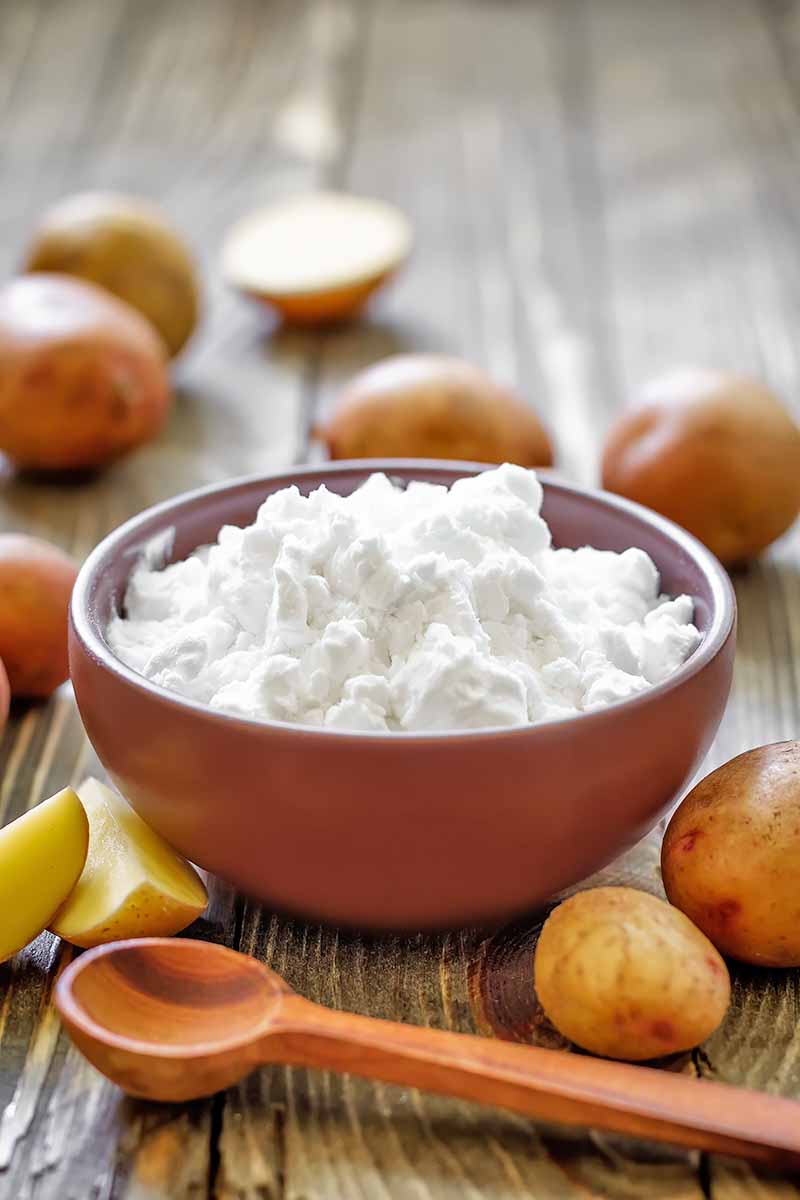
Because potatoes hold water, it works well cup-for-cup in yeast bread recipes. Even at 20 percent of the total flour, potato improves the texture, aroma, and flavor of flatbreads. It is also an excellent thickener for gravies, sauces, and soups.
Bob’s Red Mill Potato Flour, available on Amazon
Bob’s Red Mill Potato Flour has 3 grams of protein, 3 grams of fiber, 0 grams of fat, 38 grams of carbohydrates, and 160 calories in a quarter cup.
It’s available via Amazon.
In addition to potato flour, you may also come across potato starch. It is a cornstarch substitute and can withstand higher cooking temperatures. A good thickener, it adds moisture to baked goods.
A typical GF cake flour blend will likely call for wheat alternatives, like rice, and a starch, like potato or tapioca.
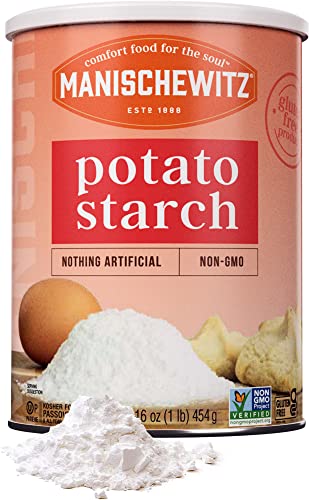
Manischewitz Potato Starch, available on Amazon
And sometimes, you’ll come across a recipe that calls for all potato starch, like our gluten-free, lactose-free Mandarin orange sponge cake.
Potato starch has 4 grams of protein, 2 grams of fiber, 0 grams of fat, 24 grams of carbohydrates, and 110 calories per quarter cup.
Manischewitz Potato Starch is available via Amazon.
16. Quinoa
We make quinoa flour by grinding the whole grains into a nutrient-rich, complete protein powder with all 9 essential amino acids.

Substitute it cup-for-cup in place of wheat, or blend half a cup with half a cup of another GF four to enjoy a tender, moist crumb that’s especially welcome in cookies and brownies.

Judee’s Quinoa Flour, available on Amazon
Dried, powdered quinoa has 4 grams of protein, 2 grams of fiber, 2 grams of fat, 19 grams of carbohydrates, and 110 calories per quarter cup.
Judee’s Quinoa Flour is available via Amazon.
Learn more in our guide, “Cooking with Quinoa.”
17. Rice
Rice is the grain or seed of a grass plant. To make flour, we can leave the hulls in place or remove them before grinding the grains.
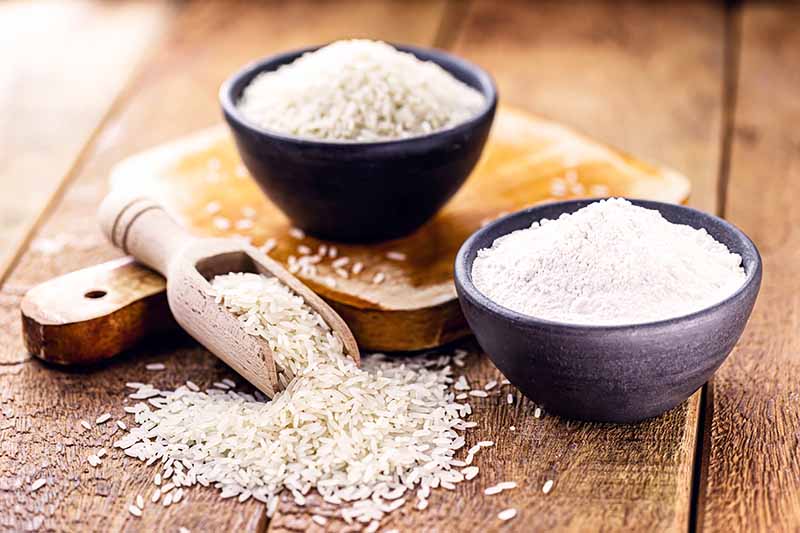
Whole-grain brown rice yields a nutty, carb-rich product. It adds texture and flavor to baked goods, but its density makes it best suited to combining with other GF alternatives for a lighter, more voluminous bake.
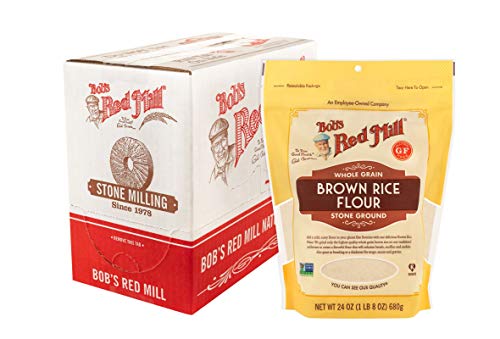
Bob’s Red Mill Brown Rice Flour, available on Amazon
Ground brown rice contains 3 grams of protein, 1 gram of fiber, 1 gram of fat, 32 grams of carbohydrates, and 150 calories per quarter cup.
This brown rice version from Bob’s Red Mill is available to purchase now via Amazon.
The white rice variety is not whole-grain because we remove the outer hull before milling. It lacks the earthiness of brown and is flavor neutral. Like brown rice, it is dense and best used in a GF blend.
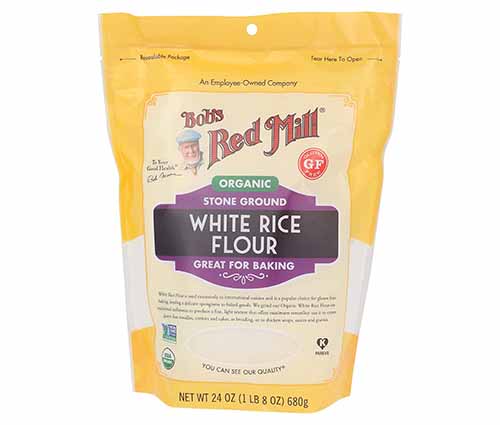
Bob’s Red Mill White Rice Flour, available on Amazon
This product from Bob’s Red Mill is available via Amazon.
Ground white rice has 2 grams of protein, 0 grams of fiber, 0 grams of fat, 34 grams of carbohydrates, and 150 calories per quarter cup.
Rice flour is a mainstay of GF baking and a common ingredient in wheat-alternative blends for baking staples like breads and rolls.
In addition to brown and white, there’s also a sweet rice variety. It’s milled from short-grain white rice and has a high starch content for a sticky texture. Often referred to as “glutinous,” although it is wheat-free, sweet rice binds ingredients well and adds moisture and sweetness to baked goods.
You’ll find more information in our guide, “White Rice Flour and Sweet Rice Flour: What’s the Difference?”
18. Sorghum
Sorghum, aka great millet or milo, is a cereal grain. We grind entire whole grains to make a nutty, earthy product that bakes to a texture more like wheat than most GF alternatives.
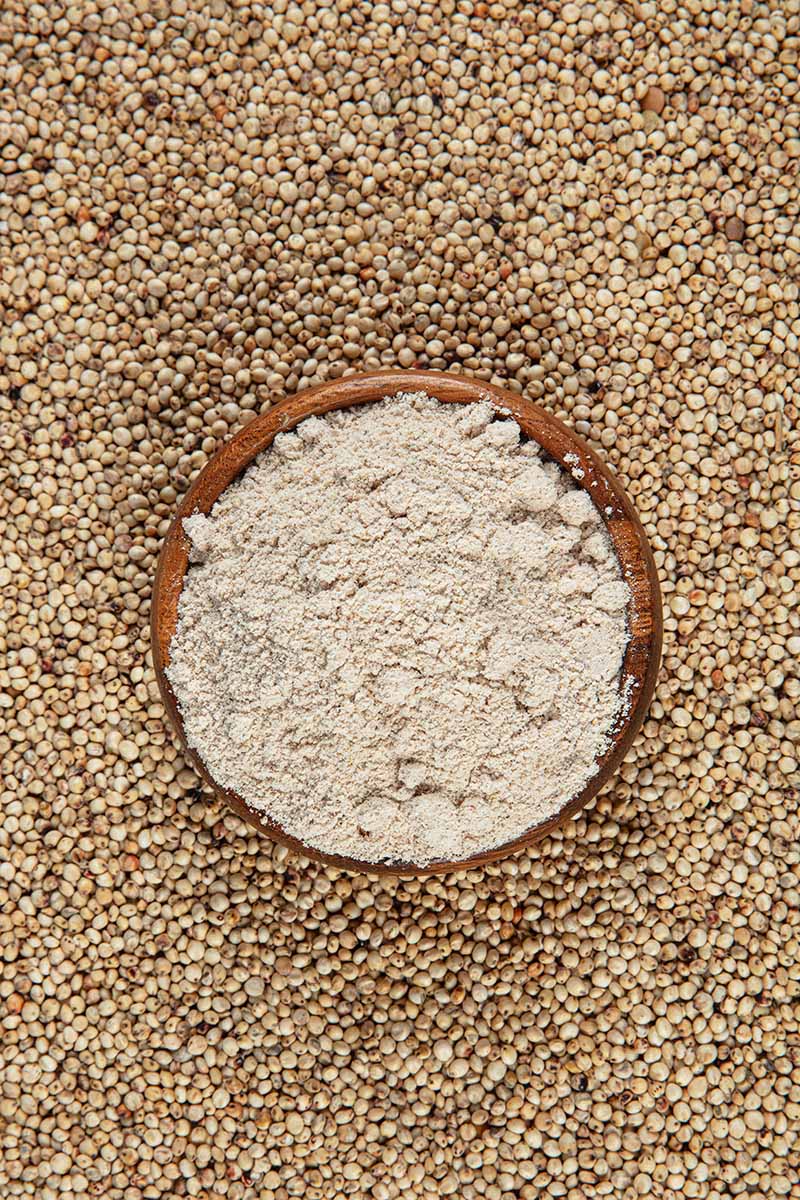
It’s an excellent addition to GF blends, contributing richness, rather than overwhelming cakes, cookies, muffins, and quick breads. Fifteen to 20 percent of a total blend is just right.
Different types and colors include black, burgundy, cream, and tan. Here’s a sweet white sorghum to try.
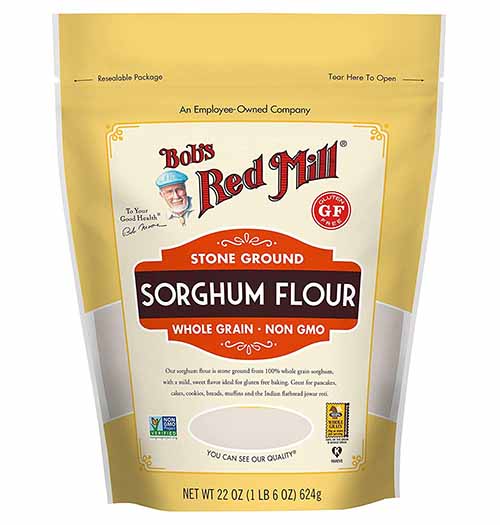
Bob’s Red Mill Sweet White Sorghum Flour, available on Amazon
Sweet white sorghum flour has 3 grams of protein, 2 grams of fiber, 0.5 grams of fat, 28 grams of carbohydrates, and 130 calories per quarter cup.
This particular variety of stone-ground sorghum from Bob’s Red Mill is available to purchase via Amazon.
Learn more in our guide, “What is Sorghum?”
19. Teff
Teff is a grass similar to millet, with the smallest edible grains in the world. There are several kinds, including dark red, brown, and ivory. We grind the grains into a powder that has an earthy, nutty taste.

Typically used to bake flatbread, you can add teff to GF blends at a ratio of 25 percent to vary the flavor of your baked goods.
Bob’s Red Mill Stone-Ground Teff, available on Amazon
Ground teff has 4 grams of protein, 1 gram of fat, 2 grams of fiber, 27 grams of carbohydrates, and 130 calories per quarter cup.
This stone-ground product from Bob’s Red Mill is available via Amazon.
Bake the Gluten-Free Way
At first, I felt deprived when I had to give up my favorite foods and adhere to a strict gluten-free diet for the foreseeable future.
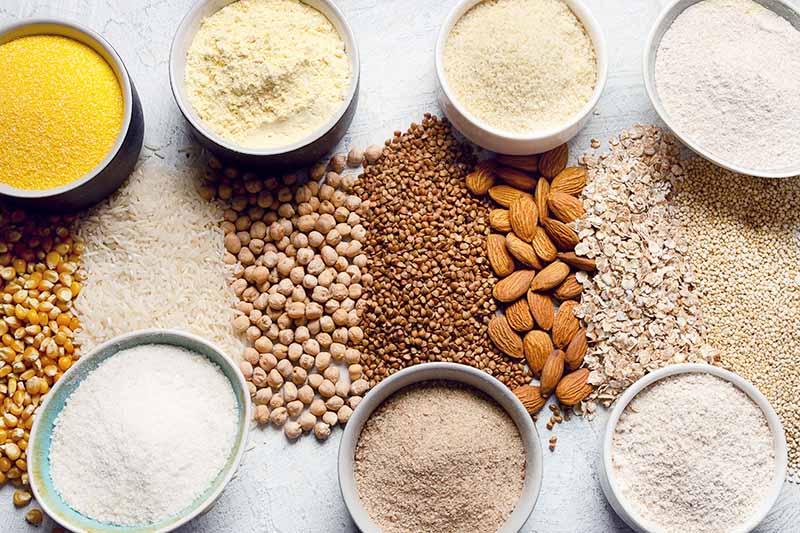
But today, with so many alternatives to wheat and recipes readily available, it’s easier to replicate old favorites and master new ones.
Our recipe for gluten-free chocolate chip chickpea blondies is a perfect example.
It’s a vegan and gluten-free version of a favorite childhood treat that calls for arrowroot starch, brown rice and chickpea flours, and tapioca starch. Coconut oil and applesauce combine with the dry ingredients for a moist bite with high notes of caramel and nutty undertones complemented by semi-sweet chocolate.
Yum!
You’ll find more delicious recipes in the gluten-free section of Foodal, and take a look at our compilation of gluten-free cookies if you want a worry-free sweet treat.
In addition to using gluten-free recipes, you can purchase a cup-for-cup GF blend to substitute for wheat in traditional baked goods.
You may like Gluten Free Measure for Measure from the King Arthur Baking Company. It’s also available on Amazon.
Gluten Free Measure for Measure, available from King Arthur Baking Company
It contains rice, whole grain brown rice, and whole sorghum flours; tapioca and potato starches; cellulose (plant-based fiber); xanthan gum; and an enriching vitamin and mineral blend. Substitute it cup-for-cup in your favorite traditional recipes.
And here’s a cookbook that takes the guesswork out of mixing gluten-free, wheat-alternative blends and making creative substitutions.

Gluten-Free Baking At Home, available on Amazon
“Gluten-Free Baking At Home: 102 Foolproof Recipes for Delicious Breads, Cakes, Cookies, and More” is written by Jeffrey Larsen, a cooking instructor, food stylist, pastry chef, and recipe developer with a personal stake in gluten-free food preparation.
Step-by-step instructions with photos guide the reader through recipes ranging from airy yeast breads to flaky pies, moist cakes, and much more in this 288-page hardcover volume, also available for Kindle.
“Gluten-Free Baking At Home” is available via Amazon.
It’s time to stock your pantry and get back into baking, the gluten-free way, with 19 delicious alternatives to wheat!
What gluten-free products do you like to use? Do you have any favorites in this list? Share your experience in the comments section below.
If you found this guide helpful, we recommend the following articles to further your knowledge of gluten-free cooking and introduce the prospect of home-milling grains:
- Foodal’s Guide to the Basics of Gluten-Free Cooking
- The Complete Countertop Grain Mill Buying Guide
- What Types of Whole Grain Can You Grind at Home?
© Ask the Experts, LLC. ALL RIGHTS RESERVED. See our TOS for more details. Product photos via Amazon and King Arthur Baking Company. Uncredited photos via Shutterstock.
About Nan Schiller
Nan Schiller is a writer from southeastern Pennsylvania. When she’s not in the garden, she’s in the kitchen preparing imaginative gluten- and dairy-free meals. With a background in business, writing, editing, and photography, Nan writes humorous and informative articles on gardening, food, parenting, and real estate topics. Having celiac disease has only served to inspire her to continue to explore creative ways to provide her family with nutritious locally-sourced food.

